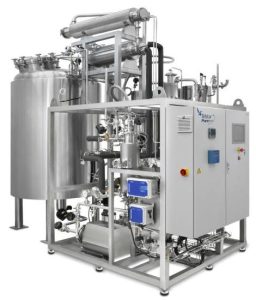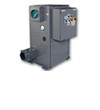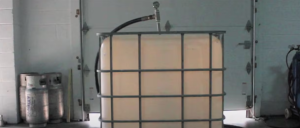One thing to consider when sizing a heat exchanger is the temperature difference of the fluids you wish to use. While heat exchangers do a great job at transferring energy, they are limited by the heat source or heat sink you provide them. No matter how large a heat exchanger is made for your process, it cannot exceed the cooling or heating provided by the utility.

The above chart is a common temperature-location curve for a counter-current heat exchanger. The hot fluid would enter on the “left” end of the exchanger at its highest temperature, and cool down as it reaches the Cold Side Inlet. The cold fluid enters from the “right” and heats up as it exchanges its energy with a temperature increasing hot source, approaching the highest temperature of the Hot Side Inlet. If the two fluids ever reached an equal temperature then the heat transfer would cease from that point on. Counter-current designs prevent a temperature pinch as well as reduce the size of the heat exchanger.
The equation for the heat load “Q” (Btu/hr) done by a system is Q = U*A*LMTD. “U” would be the overall heat transfer coefficient for the process, “A” would be the surface area, and “LMTD” is the log mean temperature difference. The easiest way to look at the LMTD is as a comparison of the two fluid’s temperatures throughout the exchanger. Since most exchangers are counter-current, comparing either end of the exchanger gives a simplified example of the LMTD. This would be the hot outlet and cold inlet, or the cold outlet and hot inlet. If a process has a large LMTD (meaning your recently cooled HOT side is still at a much higher temperature than your recently heated COLD side), the heat is transferred more easily and the surface area for your required heat load is reduced. If you were running a tight process and needed to cool very close to your utility temperature, the LMTD would be very small and thus require a large amount of surface area to achieve the desired heat transfer.
One assumption for this relationship is that the specific heat of your fluids remains constant. If you have a relatively small temperature range then this is normally the case. If you had a great temperature change or were condensing or vaporizing, then we must also compensate for the latent heat of the phase change and evaluating your LMTD becomes more complicated.
If you were looking for a new heat exchanger and are unsure of what size you might be expecting, keep the LMTD you are providing it in mind. The LMTD will generally dictate the number and style of plates within the unit (length of the plate pack), while the amount of flow you wish to use will dictate the port size needed (height and width).
Feel free to contact us with any questions or for more information.



